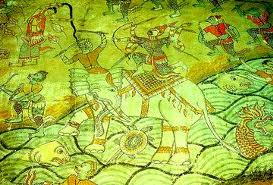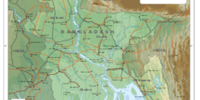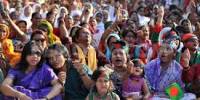Folk literature of Bangladesh
Folk Literature is created by preliterate communities and passed down orally from one generation to another. Though folk literature of one region may have similarities with that of another region, it tends to flourish in a certain geographical region. Although composed by individuals, folk literature, by the nature of its composition and preservation, becomes a collective product and assumes the traditions, emotions, thoughts and values of the community. Because folk literature is oral, it tends to rely on some mnemonic devices and patterns of language and style. Nevertheless, it is replete with artistic beauty, wit and joy.
Folk literature, by its nature, is conditioned by the land and its environment. The temperate climate of Bengal, where people do not need to struggle much for a living, has made the people lazy but has also given them time to appreciate nature and its changing faces, to sing about the land and the rivers, about the rain or the lack of it, abuty the pleasures or pains of the different seasons. The rich folk literature of this land includes FOLK SONGs, balladds, FOLK TALES, folk drama, rhymes, incantations, RIDDLES and PROVERBS that draw upon the indigenous culture of this land but which, through the centuries, have also absorbed alien cultures and been modified in the process.
Folk songs are set to tune and passed down orally from one generation to another. Folk songs express the litesyle of the rural people, with all their hopes, expectations, sorrows and dreams. Everything, starting form individuals to society and from religion to occupations, influences the form of folk songs. Nature, environment, seasonal diversity add to the beauty of folk songs. The BARAMASI (song of twelve months) describes the joys and sorrows of village women through the twelve months of the Bangla year. The lives of boatmen and world of rudders, rivers, boats, sails, waves, banks inspire the long-drawn BHATIYALI (song of the river0, while the vast expanses of the land, the distant horizon, the sun and clouds, tiring afternoons and days inform the BHAWAIYA (song of the land-. Folk songs are also inspired by be search for the perfect being and communal harmony as in BAUL songs. They are also inspired by the desire to have a happier, more harmonious conjugal life giving rise to the vatogan (song of nows) that accompany vrata puja (vow taiking). Muslim culture added JARI GAN (the song of sorrow, from zari, Persian for sorrow), which describes the sorrows and sufferings associated with MUHARRAM. Other folk songs include the sari, jhumur, ghatu, MURSHIDI and GHAMBHIRA.
Folk songs may be sung by professional or amateur singers. Gayen or bayati are professional singers who sing in groups, while kaviyals take part in song tournaments. Chhokra in ALKAP and ghatu in ghatu songs are professional singers and dangers. Udas (ascetic) bauls sing as part of their mystic search, while vairagi and vairagini or bostam and bostami sing while begging for alms. Professional singers called gidal sing at wedding ceremonies, though amateur women singers also take part in wedding songs. Almost every village woman can sing these songs. Farmers, working people, cowherds, boatmen all sing songs while working or resting.
ASHUTOSH BHATTACHARYA classified folk songs under fore heads: regional, practical, ritual, work-related and devotional. But taking the subject matter into account, there are seven categories of folk songs: love, ritual, philosophy and devotion, work and labour, profession and occupation, satire and fun, and mixed.
Worldly love is central to the folk songs and describe love between man and woman, Heavenly love is the subject of devotional songs. Bodily love, lust, quarrels between man and woman and union and estrangment are manifest in songs like alkap, based on the love of Radha and krishna, kabigan, Ghatugan , jhumur, baramsai, Meyeligit , jatra gan, Sari Gan, Holi gan etc. Some examplies are bane kamur bansi bajilare (Krishna plays a flute in the wood, alkap), ki herilam jammay asiya go sajani (What have I seen here in the Jamuna! ghatu gan), suna go radha, bali tore (I tell you Radha, jhunuar), magha na masete madhava mathura gamana (I go to Mathura before Magh comes, baramasi), tuimore nidaya kaliya re (You, my cruel lover, bhawaiya), man duhkhe maribe suval sakha (I will die of infliction, song of estrangement), sumdari lo bairaiya dekh, syame bansi bajaiya jay re (Come out, darling, and see, Here goes Syam plying on a flute, sari gan), nidhubane syam kisor sare khelba holi ay (We’ll frolic in the holi rituals in union, songs of holi), etc. Although replete with words like Radha, Krishna, suval, mathura, jammuna, BANSI, etc, these songs do not have any religious or spiritual overtone. They rather deal with humanity and worldly wisdom.
Carters, keepers of buffaloes, mahouts, boatmen, merehants, tradesmen, rivers, haors etc are often the subjects of songs as in the following examples o ki gariyal bhai, kata rabo ami panther dike chaya re (Oh my carter! How long will you make me wait for you, bhawarya), are geile ki asiben mor mahut bandhu (Will you ever return if I let you go now, bhawaiya), amar badi yan o mor paraner masisal re (Oh my keeper of buffaloes, go the my house, chatka), o mor baniya bandhu re (Oh my tradesman, bhawaiya), sujan majhi re, kon ghate tagaiba tor mao (Oh boatman, man friend. where will you anchor your bout? bhatiyali). sundairya majhir no ujan chalo dhaiya (Oh the boat of a handsome boatman, keep taking an upstream course, sari gan), etc.
Many folk songs are inspired by the emotion of love. often depicted in images drawn from the life of the land: gao tola kanay he, kanya pindo biyar sari (Cheer up, girl, put on your wedding sari), ghate dinga lagaiya jmajhi pan kheya yao (Anchor your boat, and have a betel leaf), kata pasan baindyachha pati mamete (How cruel can you be, my husband?). jol bhara sundari kanya jale diya man (Carefully fill up your pitcher with water), lal nil chair baiya, hate jao re sonar naiya (My prized boatman, row your boat to the market).
Ideas of the body and the soul, the guru and his disciple, of God and the humble devotee inform religious folk songs like baul, murshidi, marphati, MAIZBHANDARI etc. Bauls, fakirs, vairagis sometimes pray directly to God, sometimes they pray through gurus or murshids: khanchar bhitar achin pakhi kemme ase jay (How does the unknown bird enter and go out of the cage? baul), manmajhi tor baitha nere ami ar baite partam na (Oh my mind-boatman, take the oar. I cannot row further, bhatiyali), bhavanadi par kare dao dayal murshid amare (Oh my murshid, help me cross the sea of this world, murshidi), o ki chamatkar, bhandare ek ajab karbar (Oh how beautitul some wondeful things are taking palce in the world, maijbhandari).
All religious folk songs, however, are not seeking unioun with the perfect being. In fact, many devotional or religious songs ask for boons and blesings from God or the deities. A very well-known song, for exzample, prays for rain: alla myagh de pani de, cvhhaya de re tui (Oh God, give us clouds, rain and shelter). But it is not always to God that people pray for rain, but also to the clouds: megh rajare tuini sudar bhai/ek jhadi megh de bhijya ghare jai (Oh clouds, come and shower on me, so thaty I can go back home completely wet). A type of song called hudmar gan is popular among the BAJBANGSHI farmers in RANGPUR. During drought, the wives of formers come out onto the fields at night and sing to Hudma, the rain god.
The songs known as BHADU, TUSU and jawa of the RADHA region, on the western bank of the Ganges, are also devotional in nature. Jawa songs are sung at the time of planting of seeds and bhadu at the time of harvest, In folk religion – which continues to underlie received religion – the fertility of the land is associated with that of women, Thus young women observe the vow of bhadu in the hope of a successful married life. Other devotional songs include the GAJAN and GAMBHIRA, sung to SHIV, the god of agriculture. The gajan, composed on the family life of Shiv and Parvati, in essence reflects the life of farming families as can be seen in the song dhan lada dhan lada, gori, aulaiya mathar kesh (Spread the rice, oh beautiful lady, spread the rice, forget about your uncombved hair.) Another form of gajan complains to Shiva about family needs and problems, as in the song shiva, tomar lilakhela kara abasan/hujhi banche na ar jan (Shiva, stop playing your games, we are almost done). Though originally gambhira was addressed to Shiva, these days the songs highlight various aspects of polities, society, education, economy, natural disasters, corruption etc.
Another type of song is MAGAN SONG (song for good offering), which is sung by children, cowherds and farmhands when they go from door to door, begging ingredients for SHIRNI, a form of sweetened rice to be offered to Goaila and Goraksnath. It is believed that this offering will please the deities and keep cattle safe. Since cattle are important in farming, people offer shirni to supernatural beings to ensure the safety of their cattle.
The Muslim community also has similar songs, called Jag Gan, which arwe sung to ask boons of pirs (spiritual elders). These songs praising pirs are sung throughout the night. Among the pirs believed to hold the power to bless barren women with children, cure diseases, bestow wealth and save cattle are TGazi Pir, Madar Pir, Khwaja Khizir, Manik Pir, Sona Pir and Badar Pir. The songs meant for Gazi Pir are known as Gazir Gan. It is customary in some places to undertake vows to hold sessions of Gazir gan, to secure the well-being of children, health and wealth.
jari gan, or mourning songs, based on the tragedy at Karbala, are sung during Muharram by group singers. The note of jari gan is that of pathos, reflecting the sadness of the death of Imam Hussain and his companions, including small children and young men. Of late the subjects of jari gan have widened to include the jari of the qurbani (sacrifice) of Islam’, the ‘jari of Independence Day’ etc. Muharram songs also include the mourning elegies known as marsia.
Karmasangit, or songs of work, are sung during polishing, harvesting, threshing, rowing, thatching, knitting nets, weaving, digging, dragging heavy objects etc. These songs are meant to encourage people during labour and to provide recreation. The words of these songs directly relate to the nature of the work, such as ayre tora bluni nidaite yai (Come, let’s to weed the field), amra dhan bhanire dhekite par diya (We pound paddy in the dheki) and raiger nao rangeer baitha, range range bao (Cheerfully play the colorful oars of the colorful boat).
Hindu painters who draw on paper and paint earthen pots also sing while they work or when they display their wares for sate. The songs of the painters are based on the drawings of Radha and Krishna, Rama and Sita, Nimai Sannyast, Gazi pir etc. An earthen pot called Panchakalyani, from Mymensingh, protrays Shiva, Krishna, Sita, Nitai and a prostitute.
Snake charmers also have their own songs, which they sing when they display their snakes.One such song calls out to the housewife to come out and see the snake charmer and his snakes; sap khela dekhvbi yadi ay re sona bau, emni khela saper khela dekheni to keu (Oh housewife, come out and see this snake dance which no one has seen before). The goddess Manasa, and Behula and Laksindar also form the subjects of these songs. Puppeteers who wander from palce to place and hold puppet shows sing songs to the tune of Panchali, Kirtan and Malsi, These songs include narratives and dialogues, Hawkers and beggars also sing while haw3king their wares or begging for alms.
There also songs sung by professional dancing-girls when they perform the khemta dance. Eunuchs too earn their living form khemta dance and song. The subjects of the songs are light and often obscene, the love between Radha and Krishna being a dominant subject. Some other songs like chatka, Bolan, Leto etc, along with alkap, kavir ladat, khemta, meyeli git, sari and ghatu, are also solely for entertainment. Droll or lascivious, they offer temporal excitement and light humour.
Kavigan is a kind of competitive folk song sung by two groups of singers. The chief of each group is called kaviayl or sarkar. The accompanying singers are known as dohars. The two groups of singers sing by turms on stage. In kavir ladai (fight between bards) two groups of birds exchange impromptu questions and answers. Kavigan evolved in Kolkata in the nineteenth century, but later spread to all parts of the country.
Sari gan are songs related to Boats and boatmen, but generally refer to the songs sung during boat races. Themes can range form Radha and Krisha, Gauri and menaka, and Rama and Sita to historical events, and natural events. A range of tunes, TAL (measure) and rhymes are found in the songs such as asadiya naya pani aila re bhai desetel ayre o bhai ay re sabai ay re dinga baite (Fresh water has flooded hte rivers in the rainy seasib, let’s go and start rowing). man pabane beg auththyachhe bhaktir badam deo nanday (The wind has started blowing, put up a sail of devotion), syam kaliya for pirte mailam javaliya dinga sajao majhibhai jammatge yai (I’m deeply infllieted by your love. Oh boatman, prepare your boat to go to the river Jamuna) etc. Sari gan is still a popular form of folk song.
Meyeli git are sung by women and depict the world of women and their sorrows and joy, Weddings are, however, the main subject of most meyeli git and are sung on different occasions during the wedding. Village women who work the Dhenki, grind spices or do other household work also sing these songs. There are meyeli gits for ceremonies like garbhadhan (ceremony on a married girl’s attaining puberty) Annaprasan (the first rice ritual of the Hindu community), upanayan (the ceremony of the holy thread), circumcision, ear-piercing etc.
Gitika form of oral narrative poetry, which, like western ballads, tell a single event or a dramatic story, through dialogue. However, Gitika tend to be longer than western ballads, Typed characters tend to predominate in gitika, Characters tend to predominate in gitika, Characters are generally not named, but referred to as prince, son of htevizier, princess, fairy princess, daemon, sorceress, merchant, gardener, ascetic, pir and falir etc. They are all inhabitants of some kingdom on earth, but without any geographical specificity.
There are two tpes of gitika: Porbabanga-gatika, which are mainly from Mymensingh and include ‘Mahuya,’ ‘Malyuya,’ ‘Chandravat’, ‘Dewana Madina’, ‘Kanka O Lila’, ‘Kamala’, ‘Dewan BVhavna’ etc. Nath Gitika focus on stories of hte conversion of Prince Gopt Chandra (Manki Chandra Rajar Gan, Govinda Chandrer Givt, Maynamatir Gan, Gopi Chandrer Sannyas, Gopi Chander Panchali etc.) and on the miracles of hte Nath guru (Goraksavijay, Minchetan).
Gitikas date back to the medieval perod and portry the norms, customs, conflicts, crises and religious and caste discriminations of a feudal society. Apart form Nath gitika, they are secular poems, inspired by human life on earth and not by thoughts of the after life.
Folk tales stories that are handed down orally from one generation to another. They are in prose and can be simple or complex, the former being shorter, the latter longer.
Based on subject, meaning and form, folk tales may be divided into 12 classes: fairy tales, mythical tales, religious tales, adventure stories, heroic stories, sage tales, historical tales, legends, animal stories, fables, comic stories and exempla, Bangla folk tales depiet human life and society. Early marriage, polygamy, dowry the doctrine of re-birth, hatred between co-wives, the stepmother’s envy, repression by the powerful, greed, sufferings of the weak and the poor, uneven distribution of wealth, religious and racial discrimination, aristocracy, conjugal love, fraternity respect for gurus and preceptors, hospitality, alms and meditation etc.
The heroes of Bangla folk tales are primarily dependent on fate and divinity, rather than on intellect, wisdom, labour, struggle or work, They are at times dependent on magic as well.
Folk drama applies to a variety of performances related to Dance, song, Music and acting for entertainment or educational purposes, Some examples of folk drama are bhasan, Jatra, Palagan, ghatu, gambhira, alkap, kavigan, puppetry, etc, while some folk dramas emphases songs others stress dandling or acting.
Folk drama usually has a two-part presentation. The first part has a preamble, instrumental choir and prayer to the gods, while the second part contains the acting, song, dance, narration, dialogue, instrumental music, buffoonery, etc. Subjects that are most common in folk drama are stories of Rama and Sita. Arjun and Draupadi, Radha and Krishna. Nimai Sannyas, Behula and Laksindar, isha khan Dewan, Firoz Dewan, Zainab and Hasan, Sakhina and Kasem, Hinifa and Jaigun, Rahim Badsha, Rupban, BVaidyani etc. Folk dramas usually have a mythical, historical, religious and political flavor. They contain imaginary events, worldly wisdom and comic elements. Apart form descriptions of joy and sorrow, repression, struggle, conflict, love and greed, etc. folk dramas, in addition to entraining, also educate people about good and evil.
Jatras, generally based on myth, history, and folk tale, are a blend of melodrama with song and dance. They are popular across the country. Earlier, boys would play the parts of women, but now have been replaced by actresses. The gambhira of Rajshahi and maldah regions is a short, two-character play of a man and his grandson, acted out with dialogue, song, dance and music. The alkap, the ghatu, and the leto involve song and dance, meant for popular entertainment. In these performances boys dressed as women act women’s roles. These performances have a note of eroticism and gay culture and appeal to their all-male audiences.
The jarigan on the tragedy in Karbala, Which is performed mainly at Dargahs (shrines), is acccompanied by songs, dance and acting. On the occasion of Muharram, a group of ten to twelve young men form a jari gan team and roam around dancing and acting. The grup has a main singer, others just chant the refrain and clap their hands. Because of the acting, jari gan is also known as jarijatra in the Rangpur region. Palagan asre similar to jatraand include goth dancing and acting Popular palagan include Baidyanir Pala, Gazir Pala, Banbibir Pala, Sakhinar Pala etc.
Rhymes (Chnada) can be for all ages and provide entertainment as well as education. Based on their subjects, rhymes may be declassified into the following groups: nursery rhymes, play rhymes, social rhymes, historical rhymes, satirical rhymes, occupational rhymes, educational rhymes, rhymes for rituals, and magical rhymes.
Rhymes that are recited or sung to calm and entertain children are called nursery rhymes. Sometimes children themselves recite nursery rhymes. Some rhymes are play rhymes, recited by young people during games such as Hadudu (game of tag), kanamachi (blind-bee) etc.
Many rhymes are recited for fun. Others educate people on ethics, morality, mathematics, astrology etc. Some rhymes originated in historical events and preserve the memory of these events in seemingly innocuous rhymes. Thus, the rhyme chhele ghumalo, pada judalo/bargi elo dese (When the children fell asleep, sitence set in, the Maharajah cavalry attacked our country) speaks of Maratha inroads into Bengal. Another rhyme recalls the activity of christian missionaries who converted people, while indigo-plantes starved farmers who were into allowed to cultivate crops other than indigo: jat marle padri dhare/dbhat marle nil bandarel bidal chokhe handa hemdo/nikuthier nil mamdo (The Christian clergy make people lose their caste, the indigo planters make people starve, the cat-eyed indigo planters, who live in indigo bungalows, look like blue goblins). The rhyme bristi pade tapur tupur nade elo ban/shiva thakurer biye halo tin kanya dan (Patter, patter goes the rain, flooding the river/ A Brahmin named Shiva is married to three sisters) indicates that polygamy was in practice at that time.
Mantras are rhymed incantations pronounced to ward off danger or bring some boon. When people want rain, they recite ay bristi jhenpe, dhan diha mepe (Oh rain, come down on us, we’ll pay you with rice); and when they want the rain to stop, they say lebur patay karancha, ei meghkhan ude va (I put a sour fruit called karancha on the lemon leaves. Hey clouds, fly away).
In vrata rites as well, rhymes are recited. In a vrata ritual of Dasputtur (ten dolls), when people ask the gods blessings for a healthy, happy lif, or in the vrata of Bhai-Fonta, when Hindu girls wish their brothers a happy, prosperous life, or in the vrata of Laksmi, when girls wish their fathers and gorthers safe journey and good business, they recite various rhymes. All these rhymes have one thing in common: worldly happiness, not bliss in the world beyond.
Some mantras are chanted to bring misfortune to others. For ezample, a mantra is recited to prevent someone from making cakes: aola chal baker pak/ yeman pitha teman thak (Foul rice and bad cooking/ Let the cake remain as it is). Other mantras are to word off misfortune and the evil eye. Thus people sprinkle water on arable land and say: jio jala, jio/hat dluiya dilam pani/ dhan hais poda khani/……. amar ksel dekhya ye naar lagay/ tar ma-pula bhate mara yay (Wake up, Spirit, wake up, I sprinkle water after washing my hands. let rice grow as a mine………. Corsed be he who casts an \rhymes, evil eye on my fields. May his mother and sons die).
There are incantations to protect wealth from theft and body form the evil influence of ghosts and goblins. There are mantras for protection from fire, snaks, tigers, elephants, wasps, flood, venom etc. Some mantras, known as bgasikaran mantua (mantras which bring people under someone’s control) are believed to possess the occult power to bring a woman under a man’s control. Some incantations are recitred while other are sung as hymns.
Riddles short compositions that pose problems to be solved. At least two persons are required to play the game or riddles. One asks the question while the other finds the answer. A very common riddle is sagurele janm tar likakaye bvas/maye chlumle putra mare chi sarganas (Born out of sea water, it resides in human habital; it dies when the mother touches her son); the key to the riddle is ‘salt’. In the riddle, the worlds ‘sea’, ‘human habitat’, ‘mother’ and ‘son’ are used as metaphors. Salt is made from seawater, but it melts as soon as it touches water.
Riddles may be composed in prose or verse. Riddles in prose are usually contained in one sentence, while riddles in verse have at least two to four rhyming lines. Verse riddles include the following Ektukhani gachhe/ranga bauti nache (A bride in red vbances/On top of a tree)- red chilli: Hay tarmuj karga kibonta ni tar dharga ki, (What to do with the waDissertation elon? There is no stalk to hold)- egg; Kather bera chhaner chhani/ erai madhye puskanni (Made up of plakns, covered with hemp, it holds a pond within)- coconut.
There are a considerable number of riddles in prose: Kathay achhe, kaje nei (It exists in words, but not in deds) – a horse’s egg; Khulle ghar; bandha karle lathi (It makes a house when it unfolds, and a stick when floded) umbrella; Kon dhane chal nei?)- dictionary, punning on the Bangla words abhidhan (dictionary), dhan (paddy) and chal (rice).
Proverbs are the shortest possible compositions of folk literature. They span from pithy sentences to rhymed couplets. But however short, they are composed on the basis of human experience, pramatic consideration, and anek sannyasite gajan nasta 9Too many cooks spoil the brot); chor palate buddhi bade (One becomes wise after the theft); for yar muluk tar (He who is mighty rules the land, or, might is right).
Proverbva dates back to the distant past. They are found in the Vedas and the Upanisads as well as in the Charyapada, the oldest specimen of Bangla Literature. Ghusukpad (11th century) used the proverb pana mase harina bairi (The tlesh of a deer is its enemy) in the Charyapada. Brfu Chandidas in Srikrsnarirtan used the same proverb in the 14th century while Mukundaram used it in Chandimaigal in the 10th century.
Though many of the different forms of folk literature seem to be threatened by modernization, there is a growing interest not just in preserving these forms but also in reviving them. Drama groups. for example, stage plagands on modern stages and folk tales, transformed into dance drames, reveal the perennial interest in these homely tales of good and evil, of virtue rewarded and evil punished. An educated mother will recite a proverb to remind her child that one becomes wise when it is too late.
Comparative Study
I have to study many books related to this study to fulfill this Dissertation paper. As for example ‘Banglar Lok Shahitha’ of Ashutosh Bhottachrge, ‘Mymenshingh Gitika’ of Denesh chandra Shen’, Bangla Dhader Bishoy Boichitra abong shamajik poricy’ of Shila Boshak, ‘Lok Shahitta’ of Ashraf Siddiki, ‘Bangalore Lok Songhkrili’ of Wakil Ahmed ‘Uttar Banger Mayli Git’ Dr. Muhammad Abdul Jalil etc. These books are written on different topics of folk lore and Folk literature. As a result, though these books are written on this related topic, none of them is suitable enough to fulfil my purpose. For this reason. to make a short description of folk culture, I have to depend on all these books.
But it is noticed that there are so many differences among these book. Such as, Wiakll ahmed said in his book that ‘Culture means the way of life, attitude , behaviour , rules and customs, festival, religion games and sports etc.’ On the other hand, Mother Hossain Chowdhury said in his book that culture means to remain live in the society suitably. Make suitable yourself, make great yourself, this is the order of the culture. By Comparing these book, it has seen that there are so many differences in these book. So I have added all these collected thesnes which will be acceptable and logical to all to fulfill this Dissertation paper.
Recommendation
i) The Condition of Folk culture of Bangladesh is not good. So Government /concern authority should take necessary steps to save and protect folk culture as early as. Possible .
- Ø Government should take policy culture in men / women in folk culture in Bangladesh.
- Ø Build up public awareness through. Education for our national heritage.
- Ø Govt. should take necessary steps for list publicity
- Ø The elements of the folk culture should be concerned from any sort of distortion /destruction.
- Ø Government should form a committee to rescued folk elements from various races of Bangladesh .
- Ø Steps should be taken at Govt. level to conserve the endangered elements of folk culture.
- Ø The qualitative value of the folk elements should be enhanced.
- Ø It should be freed from urban culture.
- Ø It should be freed from the influence of our culture.
Conclusion
The introduction or picture of a nation is found in her culture. If the culture collapses, the nation will be identify less. So every nation should protect or preserve her culture for her existence. The folklore culture of Bangles is now on the way of ruin. So it is the duty of every citizen nurture it and to prepare it. If we can protect our folk one culture, the nation will find her existence very eerily If is impossible to reflect all the folk one culture of within this very short line. I hope, it will be fulfill at the hand of extraordinary expert in the course of him.
















